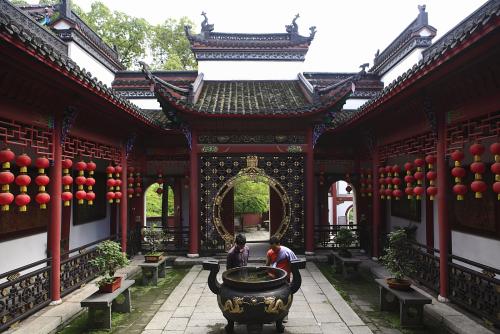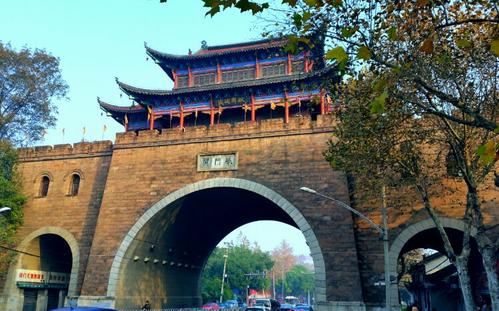Chinese Name: 晴川阁 Pronunciation: Qíng Chuān Gé
Building Time: 1547-1549
Admission Ticket Fare: Free
Best Visiting Season: All seasons
Recommended Time for Visit: 1-2 Hours
Popular Activities: Go hiking and climbing mountains
Address: No. 86, Ximachang Street, Hanyang District, Wuhan, Hubei Province
Occupied Area: About 10,000 square meters for the whole scenic spot
Building Function: The original function is to commemorate Da Yu, an ancient hero who controlled the floods in Wuhan. Now, it is a scenery spot for people to visit.
Opening Hours: 9:00-17:00 (Visitors are not allowed to enter after 16:30; Qingchuan Pavilion is closed on Monday; It is open if Monday meets the national holiday ; Qingchuan Pavilion is closed at 15:00 every Thursday.)

The Qingchuan Pavilion was built in the early Ming Dynasty at the initiative of the magistrate of Hanyang. It is named after the famous poem “晴川历历汉阳树” by the famous poet Cui Hao of the Tang Dynasty that expressed his delights after ascending the Yellow Crane Tower in Wuhan. The pavilion is one of the main buildings of the Qingchuan Scenic Area, and the rest two are the Palace of Yu and Ji (禹稷行宫) and the Iron Gate Pass (铁门关), which cover an area of 10,000 square meters in total.
In history, the Qingchuan Pavilion was destroyed and rebuilt more than five times. The pavilion underwent two greatest damages: One was that during the peasant uprising in the late Ming Dynasty(1368-1644), the Qingchuan Pavilion, as a military stronghold, was almost destroyed in the battle, and the other was that during the Taiping Rebellion (1851-1864), the Qingchuan Pavilion was damaged in the fire. In 1934, a strong wind blew down the pavilion. In 1983, the Wuhan Municipal Government restored the Qingchuan Pavilion following its former architectural style.

The Palace of Yu and Ji covers an area of 380 square meters. The palace is one of the few representative brick-timber structures with the architectural style of the Qing Dynasty(1636-1912). It is such a place where people in Wuhan offer sacrifices to Da Yu, an ancient hero who controlled floods in Wuhan successfully.

The Iron Gate Pass was built in the Three Kingdoms Period (220 AD-280 AD) as a must-have military base. During the Wude period of the Tang Dynasty (618 AD-626 AD), the Iron Gate Pass became an important passageway for Hanyang to communicate with foreign countries in terms of culture, economy and trade, and this historic relic has gradually become a place for people to visit.
Wuhan is thriving because it is near the Yangtze River. However, it also faces dangers brought about by floods. Da Yu, an ancient national hero, guided the Han River into the main river of Guishan Mountain 4,000 years ago, and successfully solved the flood disasters in Wuhan. Legend has it that the Qingchuan Pavilion Scenic Area is the place where Da Yu succeeded in controlling the flood.
Enter from the Main Entrance of Qingchuan Pavilion→ Exotic Sceneries of Chu Area→ Qingchuan Pavilion→ The Palace of Yu and Ji→ The Stele in Memory of Yu→ The Stele for the Magnificent Chu People→ Exit from the Iron Gate Pass.
Take bus 30, 531, 532, 535, 553, 559, 561, 711, or 803 and get off at the Qingchuan Avenue, Qingchuan Pavilion Station.
Chinese: 请带我去晴川阁。English: Please take me to the Qingchuan Pavilion.
Chinese: 请带我去晴川阁的西北门。English: Please take me to the Northwest Gate of the Qingchuan Pavilion.
If you go to the Qingchuan Pavilion from the center of Wuhan (New World Hotel), it takes about 15 minutes (15 yuan).
If you go to the Qingchuan Pavilion from Wuhan Tianhe International Airport, it takes about 40 minutes (80 yuan).
If you go to the Qingchuan Pavilion from Hankou Railway Station, it takes about 25 minutes (30 yuan).
If you go to the Qingchuan Pavilion from Wuchang Railway Station, it takes about 20 minutes (25 yuan).
If you go to the Qingchuan Pavilion from Wuhan Railway Station, it takes about 40 minutes (60 yuan).
If you go to the Qingchuan Pavilion from Wuhan East Railway Station, it takes about 40 minutes (60 yuan).
